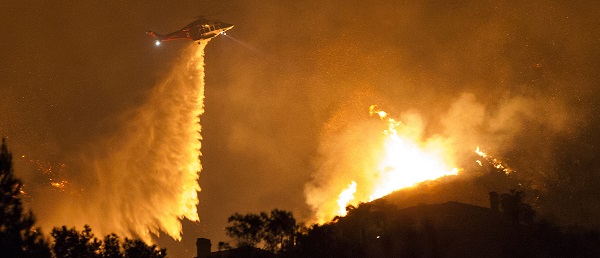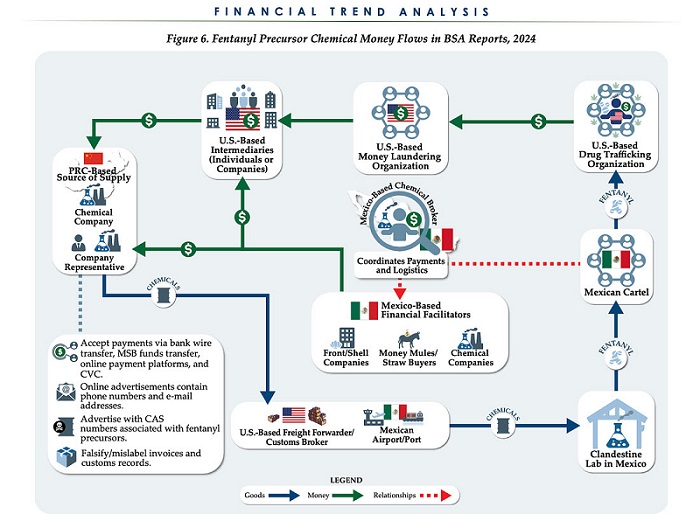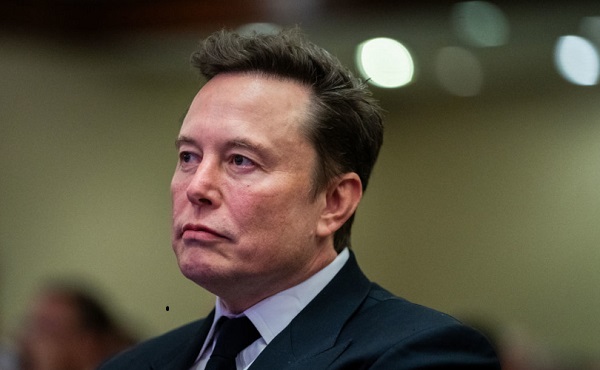Daily Caller
‘Excuses Go Up In Flames’: California Dems Paved The Way For Los Angeles To Be Consumed By ‘The Big One’


From the Daily Caller News Foundation
By Nick Pope
Southern California was known for years to be vulnerable to potentially devastating wildfires, but Democratic officials did not take sufficient action before proceeding to botch the response to fires currently devastating the Los Angeles area.
Democratic California Gov. Gavin Newsom failed to follow through on a signature 2019 initiative to revamp the state’s approach to wildfires and neglected to adequately manage wildfire kindling while a key reservoir reportedly sat empty in the lead-up to the fires that have rocked Southern California this week. While there is nuance to these shortcomings, the results of the crisis makes clear that California’s top officials failed to effectively handle a predictable and dire emergency, according to emergency management and policy experts.
“We saw this coming, and we have said, ‘I told you so’ every time there’s been a super fire. This time, the super fire happens to be even more catastrophic, because it’s happening in one of the most densely-populated areas in the United States,” Edward Ring, director of water and energy policy for the California Policy Center, told the Daily Caller News Foundation. “It’s the same message, which is that we have neglected our water infrastructure. We have mismanaged our forests and chaparral in the name of environmentalism, and we’re paying the price.”
“Anybody who says this is being politicized should be ashamed of themselves, because every time this happened in the past, the people defending the policies blamed it on climate change, which is a completely politicized issue,” Ring added. “And instead of making the hard decisions that might challenge environmentalist priorities, they did things like outlawing gasoline engines and mandating electric cars. Things like that have nothing to do with land management, they have absolutely nothing to do with the actual problem that needs to be solved.”
Ring said that inadequate use of prescribed burns and the regulation-induced decline of timbering in California have increased the density of vegetation available to fuel fires, making “the whole state a tinderbox.”
Republican Montana Sen. Tim Sheehy, who has fought wildfires in the past, also said in a Wednesday Fox News interview that “the big one” was foreseeable, adding that the devastation unfolding in Southern California is largely attributable to government mismanagement of the emergency. Some forecasts, including those issued by the National Interagency Fire Center and the California Office for Emergency Services, warned that Southern California was at high risk for serious fires in January before the fires began ravaging Los Angeles.
Joe Rogan also recounted in July 2024 that a Southern California firefighter once told him that the area had been fortunate to avoid a massive fire emergency, but that the region’s luck would run out one day when the conditions were right for a devastating blaze that could threaten the entire city.
Newsom launched a $1 billion executive order in 2019 to bolster the state’s preparedness and resiliency for wildfires. However, a 2021 investigation by CapRadio — a California-focused National Public Radio outlet — concluded that Newsom’s administration was falling short on some key facets of the program while embellishing its success publicly. Specifically, the report found that “Newsom overstated, by an astounding 690%, the number of acres treated with fuel breaks and prescribed burns” in forestry projects identified as critical for wildfire preparedness.
The 2019 executive action was taken in response to the Camp Fire of 2018, a massive fire started by downed power equipment that ravaged Northern California and killed 84 people. In response to that fire and others, news outlets and subject matter experts repeatedly pointed out that California’s lax approach to forest management creates danger by allowing fire fuel to accumulate too much.
Additionally, California’s water infrastructure has attracted scrutiny for its role in the ongoing crisis amid multiple reports that fire hydrants in some of the hardest-hit areas failed to dispense water for firefighters battling the flames. A huge spike in water demand reportedly overwhelmed underground water storage tanks and their pumping systems in higher-elevation areas as fires jumped through neighborhoods.
“The Governor is focused on protecting people, not playing politics, and making sure firefighters have all the resources they need,” Izzy Gardo, Newsom’s communications director, said in a statement provided to the DCNF.
The state has dealt with water scarcity issues for years, and it has not built a new major reservoir since 1979 despite major population growth over the same period of time. California also allows billions of gallons of runoff water to enter the Pacific Ocean each year instead of harnessing a portion for use because the state lacks sufficient infrastructure to capture meaningful volumes of stormwater, The Los Angeles Times reported in March 2024.
However, the fire hydrants failing happened primarily because the city’s water infrastructure could not handle a massive demand spike rather than a lack of available water in the wider system, according to Los Angeles Department of Water and Power (LADWP) CEO Janisse Quiñones. Additionally, a large reservoir in the vicinity of Pacific Palisades — one of the hardest-hit communities — was empty and offline when the fires exploded into a full crisis, The Los Angeles times reported Friday.
In 2014, California voters chose to enact Proposition 1, which authorized a $2.7 billion bond that would be used to fund new water storage, reservoir and dam projects. Not only did this funding fail to result in any new major reservoirs in the state, but officials actually moved in 2022 to get rid of Northern California’s Klamath River dams in order to protect salmon and steelhead.
Newsom announced Friday that he is calling for an investigation probing the factors that led up to fire hydrant failure and the reported unavailability of that articular reservoir.
Rick Caruso, a former Republican candidate for Los Angeles mayor and former head of the LADWP, said in a Thursday interview that there is ultimately no excuse for crucial infrastructure to fail when it is needed most.
“I think that career politicians have making excuses down to a fine art, and you see it rolling out and trying to explain why there wasn’t water,” Caruso said during the interview with Fox 11 Los Angeles. “Nobody wants to hear an excuse for why they lost their home, why they lost their business. The reality is, they were not prepared enough … The preparation just wasn’t right. It wasn’t enough.”
Notably, Quiñones was hired in May 2024 to run the LADWP and take home a $750,000 salary, according to local outlet ABC7. Her salary is significantly higher than that of her predecessor, and the city council said at the time that the compensation increase for the position was meant to attract top-tier talent from the private sector.
Apart from Quiñones, eight of the top ten highest-paid Los Angeles city employees in 2023 worked for the LADPW, according to analysis by OpenTheBooks, a government transparency group.
Other municipal officials have also received sharp criticism for their actions before and during the crisis. As of Friday morning, at least ten people have died, while early projections for total damages from the fires range from about $50 billion to as much as $135 billion.
Democratic Los Angeles Mayor Karen Bass was in Ghana when the fires broke out as part of a delegation sent to the country by President Joe Biden. On her way back to the U.S., a Sky News reporter confronted Bass at an airport with basic questions about the disaster, but Bass ignored the questions until she was able to get away from the journalist.
Bass addressed the fire in public remarks delivered on Wednesday night in the city, though she received criticism for making a gaffe that indicated her prepared comments had not been adequately edited before she got up to the podium.
Additionally, Bass approved a budget for the Los Angeles Fire Department (LAFD) for the current fiscal year that contained $23 million less than the prior year’s amid ongoing negotiations between the city and the firefighters’ union, according to The New York Times. The city set aside unappropriated cash expecting that a deal would eventually be reached — which eventually happened in November 2024 — before moving the funds over to the fire department’s accounts, with LAFD ultimately receiving $53 million more than last year all in.
Either way, LAFD Chief Kristin Crowley complained about the budgeting issue — including reductions in funding available for overtime pay — in December 2024, writing in a memo that the cuts presented “unprecedented operational challenges ” for her department.
Crowley’s leadership of LAFD has also been scrutinized in light of the unfolding disaster. She took over the top job in 2022, with her official LAFD bio page and media reports touting her sexual orientation as a key credential.
Throughout her tenure atop LAFD, Crowley has emphasized the importance of fostering diversity, equity and inclusion (DEI) in her department to complement the LAFD’s official 2021 “racial equity action plan” suggesting that a demographically diverse fire department is an effective one.
“Politicians and officials can spin whatever narrative they want to cover their tracks,” Frank Ricci, a former fire department battalion chief in Connecticut who now works as a fellow for the Yankee Institute, told the DCNF. “But, when it comes to emergency management, the brutal truth is this: your preparation is only as good as its performance in a crisis. If your systems fail when they’re needed most, all your excuses go up in flames.”
Representatives for Bass and the LADWP did not respond to requests for comment.
Business
Ted Cruz, Jim Jordan Ramp Up Pressure On Google Parent Company To Deal With ‘Censorship’

From the Daily Caller News Foundation
By Andi Shae Napier
Republican Texas Sen. Ted Cruz and Republican Ohio Rep. Jim Jordan are turning their attention to Google over concerns that the tech giant is censoring users and infringing on Americans’ free speech rights.
Google’s parent company Alphabet, which also owns YouTube, appears to be the GOP’s next Big Tech target. Lawmakers seem to be turning their attention to Alphabet after Mark Zuckerberg’s Meta ended its controversial fact-checking program in favor of a Community Notes system similar to the one used by Elon Musk’s X.
Cruz recently informed reporters of his and fellow senators’ plans to protect free speech.
Dear Readers:
As a nonprofit, we are dependent on the generosity of our readers.
Please consider making a small donation of any amount here. Thank you!
“Stopping online censorship is a major priority for the Commerce Committee,” Cruz said, as reported by Politico. “And we are going to utilize every point of leverage we have to protect free speech online.”
Following his meeting with Alphabet CEO Sundar Pichai last month, Cruz told the outlet, “Big Tech censorship was the single most important topic.”
Jordan, Chairman of the House Judiciary Committee, sent subpoenas to Alphabet and other tech giants such as Rumble, TikTok and Apple in February regarding “compliance with foreign censorship laws, regulations, judicial orders, or other government-initiated efforts” with the intent to discover how foreign governments, or the Biden administration, have limited Americans’ access to free speech.
“Throughout the previous Congress, the Committee expressed concern over YouTube’s censorship of conservatives and political speech,” Jordan wrote in a letter to Pichai in March. “To develop effective legislation, such as the possible enactment of new statutory limits on the executive branch’s ability to work with Big Tech to restrict the circulation of content and deplatform users, the Committee must first understand how and to what extent the executive branch coerced and colluded with companies and other intermediaries to censor speech.”
Jordan subpoenaed tech CEOs in 2023 as well, including Satya Nadella of Microsoft, Tim Cook of Apple and Pichai, among others.
Despite the recent action against the tech giant, the battle stretches back to President Donald Trump’s first administration. Cruz began his investigation of Google in 2019 when he questioned Karan Bhatia, the company’s Vice President for Government Affairs & Public Policy at the time, in a Senate Judiciary Committee hearing. Cruz brought forth a presentation suggesting tech companies, including Google, were straying from free speech and leaning towards censorship.
Even during Congress’ recess, pressure on Google continues to mount as a federal court ruled Thursday that Google’s ad-tech unit violates U.S. antitrust laws and creates an illegal monopoly. This marks the second antitrust ruling against the tech giant as a different court ruled in 2024 that Google abused its dominance of the online search market.
Daily Caller
Daily Caller EXCLUSIVE: Trump’s Broad Ban On Risky Gain-Of-Function Research Nears Completion


From the Daily Caller News Foundation
By Emily Kopp
President Donald Trump could sign a sweeping executive order banning gain-of-function research — research that makes viruses more dangerous in the lab — as soon as May 6, according to a source who has worked with the National Security Council on the issue.
The executive order will take a broad strokes approach, banning research amplifying the infectivity or pathogenicity of any virulent and replicable pathogen, according to the source, who requested anonymity to speak candidly about the anticipated executive action. But significant unresolved issues remain, according to the source, including whether violators will be subject to criminal penalties as bioweaponeers.
The executive order is being steered by Gerald Parker, head of the White House Office of Pandemic Preparedness and Response Policy, which has been incorporated into the NSC. Parker did not respond to requests for comment.
Dear Readers:
As a nonprofit, we are dependent on the generosity of our readers.
Please consider making a small donation of any amount here. Thank you!
In the process of drafting the executive order, Parker has frozen out the federal agencies that have for years championed gain-of-function research and staved off regulation — chiefly Anthony Fauci’s former institute, the National Institute of Allergy and Infectious Diseases at the National Institutes of Health.
The latest policy guidance on gain-of-function research, unveiled under the Biden administration in 2024, was previously expected to go into effect May 6. According to a March 25 letter cosigned by the American Society for Microbiology, the Association for Biosafety and Biosecurity International, and Council on Governmental Relations, organizations that conduct pathogen research have not received direction from the NIH on that guidance — suggesting the executive order would supersede the May 6 deadline.
The 2024 guidance altered the scope of experiments subject to more rigorous review, but charged researchers, universities and funding agencies like NIH with its implementation, which critics say disincentivizes reporting. Many scientists say that researchers and NIH should not be the primary entities conducting cost–benefit analyses of pandemic virus studies.
Parker previously served as the head of the National Science Advisory Board for Biosecurity (NSABB), a group of outside experts that advises NIH on biosecurity matters, and in that role recommended that Congress stand up a new government agency to advise on gain-of-function research. Former Centers for Disease Control and Prevention Director Robert Redfield has also endorsed moving gain-of-function research decision making out of the NIH to an independent commission.
“Given the well documented lapses in the NIH review process, policymakers should … remove final approval of any gain-of function research grants from NIH,” Redfield said in a February op-ed.
It remains to be seen whether the executive order will articulate carveouts for gain-of-function research without risks of harm such as research on non-replicative pseudoviruses, which can be used to study viral evolution without generating pandemic viruses.
It also remains to be seen whether the executive order will define “gain-of-function research” tightly enough to stand up to legal scrutiny should a violator be charged with a crime.
Risky research on coronaviruses funded by the NIH at the Wuhan Institute of Virology through the U.S. nonprofit EcoHealth Alliance typifies the loopholes in NIH’s existing regulatory framework, some biosecurity experts say.
Documents obtained through the Freedom of Information Act in 2023 indicated that EcoHealth Alliance President Peter Daszak submitted a proposal to the Pentagon in 2018 called “DEFUSE” describing gain-of-function experiments on viruses similar to SARS-CoV-2 but downplayed to his intended funder the fact that many of the tests would occur in Wuhan, China.
Daszak and EcoHealth were both debarred from federal funding in January 2025 but have faced no criminal charges.
“I don’t know that criminal penalties are necessary. But we do need more sticks in biosafety as well as carrots,” said a biosecurity expert who requested anonymity to avoid retribution from his employer for weighing in on the expected policy. “For instance, biosafety should be a part of tenure review and whether you get funding for future work.”
Some experts say that it is likely that the COVID-19 crisis was a lab-generated pandemic, and that without major policy changes it might not be the last one.
“Gain-of-function research on potential pandemic pathogens caused the COVID-19 pandemic, killing 20 million and costing $25 trillion,” said Richard Ebright, a Rutgers University microbiologist and longtime critic of high-risk virology, to the Daily Caller News Foundation. “If not stopped, gain-of-function research on potential pandemic pathogens likely will cause future lab-generated pandemics.”
-

 Business1 day ago
Business1 day agoChina, Mexico, Canada Flagged in $1.4 Billion Fentanyl Trade by U.S. Financial Watchdog
-

 2025 Federal Election2 days ago
2025 Federal Election2 days agoTucker Carlson Interviews Maxime Bernier: Trump’s Tariffs, Mass Immigration, and the Oncoming Canadian Revolution
-

 Business2 days ago
Business2 days agoDOGE Is Ending The ‘Eternal Life’ Of Government
-

 espionage2 days ago
espionage2 days agoEx-NYPD Cop Jailed in Beijing’s Transnational Repatriation Plot, Canada Remains Soft Target
-

 2025 Federal Election1 day ago
2025 Federal Election1 day agoBREAKING from THE BUREAU: Pro-Beijing Group That Pushed Erin O’Toole’s Exit Warns Chinese Canadians to “Vote Carefully”
-

 2025 Federal Election2 days ago
2025 Federal Election2 days agoCanada drops retaliatory tariffs on automakers, pauses other tariffs
-

 Daily Caller1 day ago
Daily Caller1 day agoDOJ Releases Dossier Of Deported Maryland Man’s Alleged MS-13 Gang Ties
-

 Daily Caller1 day ago
Daily Caller1 day agoTrump Executive Orders ensure ‘Beautiful Clean’ Affordable Coal will continue to bolster US energy grid




